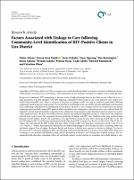| dc.contributor.author | Adwar, Claire | |
| dc.contributor.author | Puleh, Steven Sean | |
| dc.contributor.author | Ochaba, Isaac | |
| dc.contributor.author | Ogweng, Isaac | |
| dc.contributor.author | Benyumiza, Deo | |
| dc.contributor.author | Amusu, Kosta | |
| dc.contributor.author | Achola, Brenda | |
| dc.contributor.author | Ocen, Francis | |
| dc.contributor.author | Abolo, Lydia | |
| dc.contributor.author | Kumakech, Edward | |
| dc.contributor.author | Obua, Celestino | |
| dc.date.accessioned | 2022-03-14T11:30:13Z | |
| dc.date.available | 2022-03-14T11:30:13Z | |
| dc.date.issued | 2022 | |
| dc.identifier.citation | Adwar, C., Puleh, S. S., Ochaba, I., Ogweng, I., Benyumiza, D., Amusu, K., ... & Obua, C. (2022). Factors Associated with Linkage to Care following Community-Level Identification of HIV-Positive Clients in Lira District. Advances in Public Health, 2022. | en_US |
| dc.identifier.uri | https://hdl.handle.net/123456789/385 | |
| dc.description.abstract | Background. Community HIV testing helps to increase access to high-risk groups who are less likely to visit a clinic for a test. A
large proportion of people identified with HIV following community-based testing are not easily linked to care compared to
facility-based identified cases. (ere is a paucity of literature on linkage to HIV care and its predictors particularly following
community-based testing in a rural setting. We assessed the level of linkage to the care of HIV-positive individuals and associated
factors following community-level identification in Lira district. Method. A cross-sectional survey was conducted in Lira district
employing mixed methods among HIV-positive adults identified in the communities. Quantitative data were collected from 329
randomly selected study participants using interviewer-administered questionnaires. Key informant interview guide was used to
collect qualitative data. (e data were double entered, cleaned, and analyzed using SPSS version 23. Odds ratios and confidence
intervals were used to assess the association between predictors of linkage with HIV care. Qualitative data were analyzed using
thematic content analysis. Results. (e respondents were aged between 18 and 85 years with a mean age of 42.9 (SD � 11.6). (e
level of linkage to HIV care following community-level identification of HIV testing in Lira district was 98% (95% CI 96.07–99.33).
Clients who self-initiated the HIV testing were more likely to link to HIV care than their counterparts (AOR � 9.03; 95% CI
1.271–64.218, p � 0.028). Key informants identified factors influencing linkage to care as health education, counseling, follow-up,
and family support. Fear of stigma, disclosure, denial, and distance to facility were reported as barriers to linkage. Conclusion/
Recommendation. (e level of linkage to HIV care following community identification was found to be excellent (98%). Predictors
to linkage to care included self-initiated testing, positive perception of distance, and waiting time at health facilities. We recommend
health education, counseling, follow-up, and family support as interventions to strengthen successfully linking to careLin | en_US |
| dc.language.iso | en | en_US |
| dc.publisher | Hindawi Advances in Public Health | en_US |
| dc.subject | Linkage | en_US |
| dc.subject | HIV | en_US |
| dc.subject | Lira District | en_US |
| dc.title | Factors Associated with Linkage to Care following Community-Level Identification of HIV-Positive Clients in Lira District | en_US |
| dc.type | Article | en_US |

